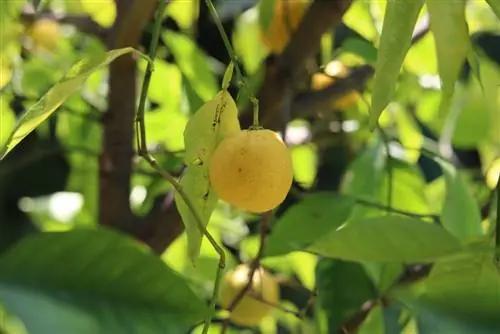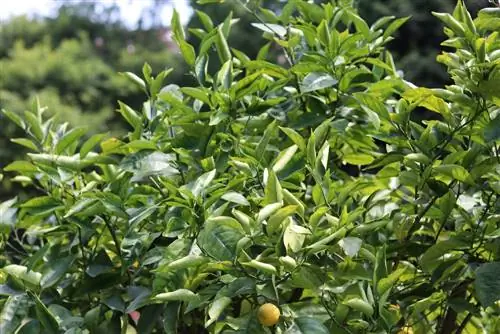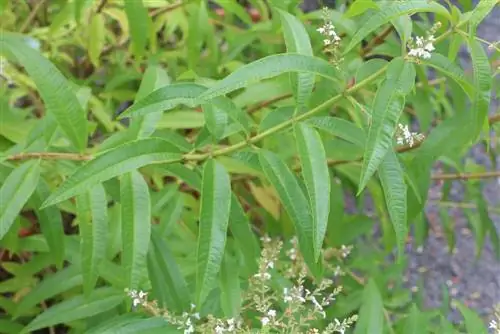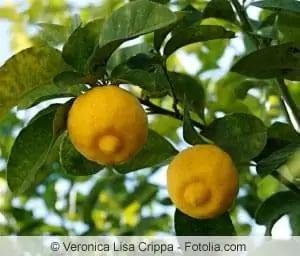- Author admin [email protected].
- Public 2023-12-17 03:39.
- Last modified 2025-01-24 12:45.
When cutting the lemon tree, the motto is: less is more.
Lemon trees grow relatively slowly and are not particularly easy to cut. This guide will tell you when the optimal time is for maintenance and upbringing and how exactly to go about it. You will also find out what you have to do in terms of cutting if you want to train a young plant to become a standard plant. Finally, we provide information about the so-called rejuvenation pruning for older lemon trees that have not seen secateurs for a long time, and give brief information about the lemon tree in espalier form.
A he althy lemon tree requires maintenance and training pruning. Below we will go into detail about the two care measures.
Conservation cut
Maintenance pruning can be carried out at any time - throughout the year. It is always necessary when plant parts are dead or otherwise damaged. By removing them, you relieve the lemon tree and give it the opportunity to use its power sensibly.
Tip:
Experience has shown that it is precisely in unsuitable winter quarters that the evergreen plant loses many leaves and branches and twigs die. If you can't offer your lemon tree adequate space for overwintering, you'll have to be prepared for a lot of work.
How to do it
1. Step
Make the cut on the last piece of the still living branch.
Note:
In this way you give your tree the chance to close the interface again.
2. Step
Has an entire branch died completely down to the next branch? Then cut it off from the next largest branch or trunk - as smoothly as possible.
Note:
How to avoid leaving an unsightly stub.
Basic information about conservation pruning:
- Check your lemon tree regularly (about two to four times per month) for dead or damaged branches and, if necessary, remove them using the methods described (steps 1 and 2).
- Make sure the interface is always vertical. This ensures that no water accumulates on the cutting surface. This could otherwise lead to the accumulation of bacteria and other pathogens (keyword Botrytis fungus).
- Treat larger cuts with a wound closure product suitable for the tree. This applies not only in terms of maintenance, but also in terms of upbringing.
Educational Cut
Maintenance pruning makes it quite easy for you: the dead and otherwise damaged branches clearly show that they want to be cut off. The situation is different when it comes to upbringing. Here you have to decide for yourself where to cut your lemon tree.
The two main reasons for the parental cut:
- Appearance of the plant (shaping)
- sufficient supply of light to the inside of the crown
Tip:
Give your lemon tree a shape that you like. Since it does not naturally grow as compactly as the orange tree, but rather grows wildly in all directions, we recommend that you shape the crown into either a semicircular or an inverted triangular shape.
Opinions differ when it comes to the right time: Some say that early spring (February or March) is optimal; The others are of the opinion that action should be taken in the autumn (before moving into winter quarters). Both variants each have a big advantage.
- Advantage of spring pruning: Plant starts the new season completely refreshed
- Advantage of autumn pruning: space required in winter quarters is slightly reduced
Tip:
We recommend that you decide the timing depending on your winter quarters options. If there is a sufficiently large space available, carry out the training cut in the spring. If you don't have such a parking space, it is better to prune in the fall. In any case, you should make a decision so as not to put too much strain on your lemon tree. The procedure remains the same regardless of the time chosen.
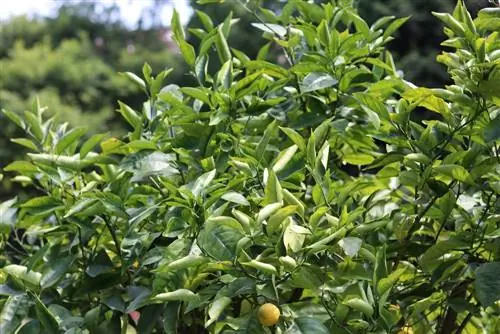
1. Step
Place the lemon tree alone in front of a light wall.
This gives you a wonderful view of the crown
2. Step
Come up with a cutting plan.
Tip:
Practical people draw a little sketch. However, it is usually enough to just imagine the procedure in your head.
3. Step
Thoroughly clean the cutting tool you plan to use.
- How to prevent bacteria, viruses or fungi from being transferred to the plant.
- A simple pair of secateurs is generally sufficient. You only need pruning shears if you have a larger lemon tree.
4. Step
Cut the branches that grow upwards to the same length if possible.
- Cut off only a few centimeters per branch (except, of course, for sickly specimens).
- It may take one to two years (or cuts) until the branches match in length.
- Shortening the older shoots encourages the plant to branch more.
5. Step
Look inside the crown for branches that cross each other, then remove the weaker version of each.
6. Step
Identify leafless, cross-growing branches at the crown root and cut them off.
How to create a beautiful transition from trunk to crown
Tip:
The focus is on thinning out the crown to allow unrestricted sunlight. Nevertheless, you should proceed carefully and carefully consider which branches really need to be removed.
7. Step
Repot your lemon tree (if necessary).
Basic information about the parenting pattern:
- If the weather is good, you can trim the lemon tree outside in the garden. This is particularly advisable if the winter quarters tend to be tight.
- It happens again and again that the lemon tree develops very long shoots very quickly. These rapidly growing elements are referred to as “water shoots” or “hot shoots”. They should definitely be removed as they are unfortunately not fruit-bearing and therefore absolutely unproductive for the development of the plant. To do this, grab the secateurs in the summer when the water shoots appear and literally make short work of it.
Train young plants to become standard stems
Have you purchased a small, bushy young plant and want to grow a standard tree from it?
Then proceed as follows:
1. Step
Tie the strongest of the centrally growing shoots vertically upwards on a stick.
2. Step
Short all side shoots (each approximately half the length).
- Cut back the thickest side shoots as much as possible. Otherwise they rob the main shoot of too many nutrients and growth power.
- Then you have to wait a year or two and more or less just watch the plant thrive.
- That's how long it usually takes until the centrally pulled shoot is long enough to form the final desired trunk length.
3. Step
Cut off any branches that remain on the trunk below the crown.
4. Step
Short the new shoots in the crown to about half their length.
How to ensure better branching.
The main tasks are now completed. From now on it's just a matter of regularly removing the newly appearing side shoots.

Tip:
After a few years, the standard tree can reach a height of three meters or more. If space is limited, it is therefore advisable to grow the lemon tree as a bush.
Rejuvenation pruning for older lemon trees
If a lemon tree is not pruned at all for many years, it can become very bald.
But don't worry: such a damaged plant can still be saved - with the so-called rejuvenation cut. During the action you bring the tree back into a neat shape.
Rejuvenation pruning is a quite radical method - that means the tree is cut a lot. In the end it appears much smaller and hardly has any leaves, flowers or fruit. Make sure you only subject your sensitive lemon tree to this procedure once.
Spring is the optimal time for rejuvenation pruning. This gives the plant the opportunity to immediately develop new, strong shoots.
How it works:
Cut the entire crown back drastically and mentally create the branch framework around which the “fresh” crown should develop. Specifically, this means: Shorten the branches to stumps that are five to 15 centimeters long.
Tip:
Don't pay any attention to leaves, buds or fruits. What must be must be. It is completely normal for the lemon tree to have nothing or little left after the rejuvenation cut.
Just two to three weeks later, numerous new shoots appear from the stumps again. The lemon tree is enjoying finally being able to develop freely again and, with your help, building a beautiful bushy crown.
Rule of thumb:
The more intensive the rejuvenation cut, the stronger the new growth.
After cutting, you have to be patient when it comes to flower and fruit formation. The lemon tree now has in mind to create a chic crown with he althy, attractive foliage. Only under this condition will it be able to feed on fruit again. This means that the first new flower buds, from which fruit can subsequently develop, will not appear until the second year after the rejuvenation cut at the earliest.
It is now important for you to specifically prevent further baldness. You can achieve this by shortening all young shoots that sprout after cutting (as long as they are still herbaceous) to a maximum length of 30 to 40 centimeters. Again, the measure contributes to better branching of the lemon tree.
Extra tip for espalier-shaped lemon trees
Every now and then you can buy lemon trees in a round trellis. With a corresponding plant, the branches are tied to the trellis structure in an arc around the tree trunk. Caring for such a specimen is not easy. This is because one cannot tolerate the branches' natural desire to grow outward from the center of the trunk.
The following must be taken into account in order to maintain a round trellis in good condition:
- Tie the new shoots continuously to the trellis arches.
- Remove regularly those shoots that grow inwards.
Conclusion
Basically, two pruning tasks need to be carried out on the lemon tree: maintenance pruning (all year round) and training pruning (autumn or early spring). It is important to always cut off dead and otherwise damaged branches to help the plant thrive. Anyone who has neglected their tree for several years cannot avoid a drastic rejuvenation cut if they want to save their green friend. The hobby gardener who wants to train a young plant to become a standard tree also has to take various measures. The same applies to maintaining a special espaliered lemon tree.

